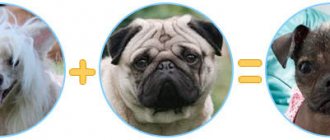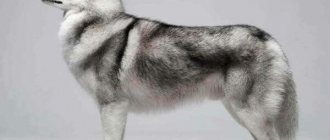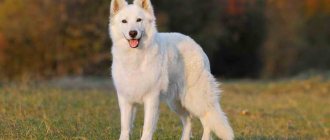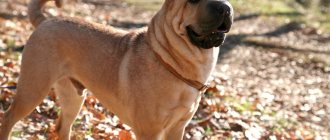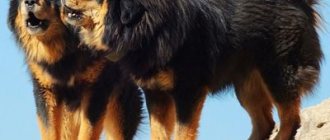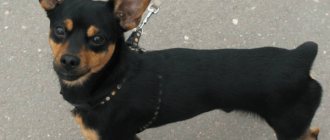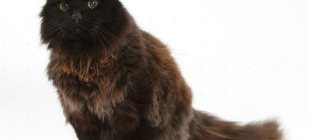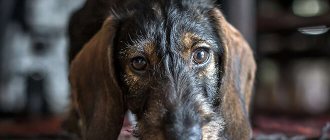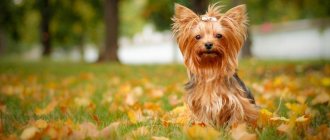The history of the appearance of the Siberian Husky breed
Sled huskies in harness are a common sight in the North.
Husky dogs come from the Far East. Their ancestors are Siberian sled huskies. The breed has been bred since Neolithic times by aboriginal tribes who were engaged in fishing and hunting sea life. Thanks to the endurance and strength of dogs, nomadic peoples were able to move around the northern regions, covering vast distances on sleds.
In the 17th-18th centuries, Russians began to actively develop sled dog breeding. To develop the regions of Siberia, they needed reliable transport for the delivery of goods, mail and the movement of officials. A larger number of dogs were required to transport a new type of capacious sled, and therefore the number of huskies increased.
During the “Gold Rush” era, the demand for sled dogs increased among Americans who visited Alaska, and in 1908 they began to import huskies to the United States for subsequent breeding and participation in racing.
Attention! The dogs showed excellent abilities to overcome difficult distances, and it is impossible to count how many heroic deeds they performed.
For example, in 1925, sled dogs saved human lives from death by delivering needed medicine from a train station to the Alaskan city of Nome, where there was an outbreak of a diphtheria epidemic.
This ancient sled dog breed was registered by American cynologists in 1934.
Grey eyes
Gray eyes in huskies are not uncommon and are most often found in dogs with light coats.
Most experts agree that the gray color of the iris is nothing more than a lighter shade of blue, which appeared as a result of a special mutation in the genome, due to which the eye color acquired an icy-gray tint.
There is such a variety of huskies as albinos, which have light gray eyes with a cold tint, but such individuals are extremely rare.
Breed standards for eye color
The Siberian Husky breed standard provides for a whole “palette” of dog eye colors:
- Brown color. It has the following shade variations: light brown, yellow-brown (amber), dark brown, green (olive).
- Blue. It includes shades: silver-white, gray, amber.
- Heterochromic color (eyes of different colors). It comes in the following combinations: blue-brown, green-brown, amber-brown, gray-blue.
Dogs have different eyes: normal or defective in the breed
Unusual different (heterochromic) eye colors in huskies are allowed by the breed standard, that is, they are not a defect or a deviation. Huskies with different-colored eyes are not only not rejected, but, on the contrary, are highly valued by breeders who breed them. Since such dogs are in great demand among buyers, puppies with this eye feature are often quite expensive. Odd-eyed huskies – “harlequins” – freely participate in exhibitions and arouse the interest of the jury.
Husky with heterochromia is the norm
Standard or defect?
As already mentioned, different eyes in a husky are not a defect or a deviation . This phenomenon is absolutely normal. But, there is a nuance here: if the color of your pet’s iris has changed in the first year of life, then this is quite natural.
If the iris changes with age, then this may be a sign of a disease and requires contacting a veterinarian.
If we talk about purebred, a Husky dog can have eyes of different colors, the most common of which are:
- Blue.
- Brown.
- Amber.
- Green.
- Heterochromic.
All this is considered the norm and is recognized by international standards.
Heterochromic irises in huskies are a unique feature that gives the dog a special mystery and beauty. It happens that the color of one eye is blue and the other is brown.
This heterochromia is called complete . But, there are cases when one pet’s eye has an even tone, and the second includes various shades (dots, spots, etc.). This option is called sectoral heterochromia.
All these phenomena are provided for by the standard and in no way indicate that the dog is not purebred.
Heterochromia and its causes
Such an amazing phenomenon in dogs as heterochromia, translated from Greek means “different color”. To put it scientifically, but briefly, heterochromia is a different color coloring of the irises of the eyes. Heterochromic coloring of the iris is very common in purebred Siberian Huskies; it can be hereditary (congenital) or acquired.
- Hereditary. It is transmitted genetically, that is, a dog is born with this feature. The reason why huskies have different eyes is an excess/deficiency of melanin in the body, which is responsible for the intensity of the color. Also, puppies with heterochromia can appear after mating blue-eyed and brown-eyed representatives of the breed.
- Acquired. Occurs against the background of long-term treatment with potent medications or chronic diseases. Heterochromia in this case is a complication.
The effect of heterochromia on the quality of vision of a dog
If heterochromia is genetic in nature, then it only means a unique feature of a particular dog. And if heterochromia suddenly appears in an adult dog, it must be taken to a veterinary clinic for examination to determine the cause.
Important! It has long been proven in veterinary medicine that such a feature as heterochromia does not in any way affect the quality of vision, therefore a husky with different eyes differs from standard representatives of the breed only in its unique multi-colored gaze.
Reasons for appearance
The main reason is a hereditary deficiency or excess of a substance responsible for the color of fur , skin and irises . This substance is called melanin. It is its quantity that will determine not only the color, but also the intensity of the shade of the iris.
The second reason is crossing individuals with different eyes, for example, a blue-eyed dog and a brown-eyed dog.
Another reason is illness. Often, as an adult dog ages, one eye begins to take on a different shade and becomes cloudier or darker.
NOTE!
Almost all newborn husky puppies have a bluish iris and at first it is impossible to determine the future eye color.
Only in the 6th month of life does the iris begin to acquire a color that will remain with the pet for life.
The most common colors of harlequins
There is a legend that thanks to the love between an icy and a hot dog, cute puppies with different eyes were born, one eye of which was colder than the ocean, and the other hotter than fire. Dogs with different eyes have absorbed both icy courage and the warmest kindness of their hearts.
Commonly occurring harlequin iris colors include the following combinations:
- Blue and brown. This combination of iris colors in heterochromic huskies is the most common of all. Occurs in dogs with black and white or gray coat color.
Heterochromia in the blue-brown color combination
- Green and brown. This is not a common occurrence among harlequins, so breeders sell puppies with such hereditary heterochromia at a higher price than pets with a combination of blue and brown colors.
- Amber and brown. Representatives with this combination are considered the most resilient during physical activity. Also, thanks to the amber and brown shades of the husky’s iris, the harlequin does not experience additional fatigue from light.
Heterochromia in amber-brown color combination
- Gray and blue. The husky has the rarest combination of multi-colored eyes. The look of a husky with light eyes seems as piercing as possible due to the fact that the pupil becomes especially noticeable on the light iris. The gray-blue combination causes some discomfort for the dog, since light irises are more sensitive to light. Especially often the dog has to squint on clear winter days, when the rays of the sun are reflected from the snow.
Heterochromia in the color combination “gray-blue”
Blue-eyed dogs and the breed standard
Why Husky has different eyes can be explained by heredity, which is passed down from generation to generation and is called heterochromia. Blue-eyed dogs more often give birth to offspring with different eyes; as a rule, puppies are born with different brown and blue eyes.
The breed standard allows not only a variety of colors in the exterior, but also the difference between the color of the iris in one dog.
So, according to the standard, different types of colors are distinguished; a prerequisite is the presence of a similar mask on the animal’s face.
Most common colors
- Brown: different shades, from light to dark brown, almost black;
- Amber type: brown with a rich yellow color;
- Blue: blue eyes, of different shades, distinctively the presence of a darker rim;
- Bicolor (heterochromia) most often blue and brown;
- Mosaic. Blotches on the main color.
Different iris color
The standard allows other variations.
Green irises
The breed standard allows greenish shades of the iris. The tints of green are more likely to be an olive color, a derivative of amber. The green in a husky's eyes can be seen from certain angles in bright sunshine, but there is no such thing as an iris the color of green grass.
Husky with green eyes
Blue-eyed huskies
Huskies with blue eyes are the most popular among breed lovers. The iris of blue-eyed dogs has a heavenly color and is surrounded by a black rim. The light iris of the blue-eyed representatives of the Husky breed makes the dog’s gaze piercingly threatening and at the same time incredibly attractive. The genetic anomaly resulted from a mutation in the genome that resulted in a lack of pigment in the iris. However, this feature of the dog’s exterior does not in any way affect the quality of their vision.
Interesting! Previously, such a husky appearance was considered a defect, and blue eyes in dogs were explained as a sign of visual impairment.
Blue-eyed husky
Grey eyes
Representatives with gray eyes are not found as often as others. The coat color of gray eyes is usually close to slate and emphasizes the beauty of the husky's eyes. The color of the iris varies from deep dark to very light gray. The rare color of the iris is truly unique; you want to look at them for a very long time.
Gray-eyed husky
Brown-eyed huskies
Dogs with brown eyes have irises ranging from warm honey to black. Due to the rich pigmentation of the iris, its color appears dense and quite bright. The amber tint in brown-eyed dogs looks especially impressive.
Interesting! In different lighting conditions, the eyes may appear orange, red, golden, or even have a greenish tint.
Brown-eyed husky
Silver-white (albino eyes)
Albino husky eyes are colorless, as is their coat. Individuals with albinism are born extremely rarely and have a silvery-white iris. The edges of the snow-white husky's eyelids, outlined as if drawn with a pencil, emphasize the silver-white color of the eyes against the background of an absolutely white coat, which gives the dog's exterior a fabulous look.
Albino husky eyes
I want to get a husky: 10 popular questions about the breed
They say that it is almost impossible to stop at just one husky. In our case, this is what happened: July of this year was marked by an addition to the flock. The older dogs Lars and Maya gave birth to six excellent strong puppies. By an effort of will we forced ourselves to reject the path of the hero Gerald Darrell, who left the entire litter in the family. The search for new families for the puppies has begun. It turned out that everyone was concerned about almost the same questions. There are legends about dogs that are uncontrollable in urban environments, eating only frozen fish and running even in their sleep. (we do not take into account the questions of a citizen who was seriously interested in the difference from pug puppies). And these questions are no different from those that we asked ourselves when we got our first dog of this wonderful breed several years ago. So…
1. “Do you have a husky with blue eyes?”
“The Legend of Balto”, “White Captivity”, “Snow Dogs”. Hollywood has planted a stereotype in people's heads about the color of husky eyes. However, blue eyes are not a sign of breed. Just like in humans, the color of a husky's eyes, like the color of its coat, can be absolutely anything: shades of gray, brown, beige or pure white - these are all huskies. Moreover, the majority of Khasi with a show career in Irkutsk and throughout Russia are brown-eyed. Many large kennels do not have a single blue-eyed dog. “There is no difference in terms of breed, but we would like to have blue eyes - it’s more beautiful. And preferably in black and white." And so we thought. But they saw Lars - a chocolate puppy with green-brown eyes - and could not resist. After all, this is a friend, and not a beautiful vase with a pedestal to match the color of the interior. And now we also did not set a goal to get offspring with a certain eye color. We both have brown eyes. The puppies were born with different eye colors, but all are equally loved and beautiful. Choose according to your heart, regardless of color, and you won’t go wrong. After three days, the color will stop worrying you, and after a month you yourself will be surprised at your own previous requests.
2. “Can we do it without documents to make it cheaper?”
Let's just say that the price of a puppy is a balance between costs and the breeder's expectations. The dog requires care, a balanced diet, including meat, and purebred huskies cannot be cheap. Why do nurseries need rare blood, is it so important that the puppies’ parents are athletes, look at that cute bear cub twirling around! But the puppy will not be this “cute” for long, but who will grow up – we look at the parents. High show scores and titles are an indicator of how much effort and money the breeder invested in his dog, how he looked after it, what he fed it, and whether he gave it the necessary physical activity. If you have a puppy with a good pedigree, you can see it right away. And it’s still nice to receive recognition at the exhibition for the stature and beauty of your dog.
3. “As long as we live in an apartment, there’s no point in thinking about a dog.”
YouTube is replete with video records from husky vandals: sofas torn to shreds, finely chewed wallpaper, chairs crushed into shavings, and feathers from pillows falling on this landscape. We lived with our first dog in the city center, in a one-room apartment on the 9th floor. At first our neighbors said: “Poor dog!” Then, meeting us several times a day in trekking sneakers, with bikes or skis, they began to feel sorry for us. After several destructions of the apartment during our busy period, our dog had to increase the load - and order reigned at home. In fact, most huskies in Russia live in apartments. If you have a great desire to get a dog, the difficulties do not seem serious. The most important thing is walking. If the dog is properly “tired”, you will not have a dog at home, but a rug. For example, if we were planning an evening together without the dogs, the task was to exhaust them so that they would sleep soundly until we returned. There is a big plus - we save on the gym. This is not to say that huskies do not misbehave - the dog has a very lively and inquisitive mind, she constantly comes up with ways to entertain herself and is bored by walking to the line. Usually, the chaos subsides when the dog celebrates its first birthday: you are used to long walks in the fresh air, and the husky is used to patiently waiting for you from work. If your apartment survives this year, you can think about renovations. As for the temperature in the apartment, huskies easily adapt without “dressing” too warmly in the fall. That is, the undercoat of an apartment husky is smaller than that of a street husky. But it has a big advantage: with constant stay and observation together, the connection with the owner and trust in him is much higher among apartment-dwelling Hasyas, which means it is much easier to raise such a dog. Tested for myself.
4. “Is it true that you need to walk with them for five hours a day?” I would like to answer “yes”) At least the dogs won’t mind. But for this you need to quit your job. One owner was so worried that he wouldn’t give his dog a proper walk that he installed a treadmill. It's not so much a matter of time as it is the intensity of physical activity. On average, about one and a half hours a day (half an hour in the morning and an hour in the evening) is enough for an adult husky, if it is not a walk on a leash. Hasya will look forward to the weekend so she can chase muskrats with you on the embankment, mice in the fields, or go on a hike on skis or bikes. Of course, the owner of a husky should also love active recreation - and take the dog with him everywhere.
But don’t think that now you are doomed to walk in any weather: with all their love for walks, huskies also do not like to walk on a rainy day, preferring to lie with the owner of the house.
5. “Who is better: a boy or a girl?”
Everything is simple here: males are more independent, females are more affectionate. Bitches need special care two to three times a year and close attention. It’s easier in this regard with a male dog, but he will periodically test your leadership, such is his nature.
6. “Husky dogs are not trainable – is this true?”
If you have time, you will change this opinion. Dogs are too self-sufficient and will not obey commands unquestioningly, but you don’t need that. The root of the problem is insufficient walking and attention. If you limit yourself to five-minute walks, the dog will dream of sneaking away from you to release energy. And neither high fences, nor enclosures, nor strong leashes will save you: it will jump over, dig under, and chew through. If you make it clear from childhood that it is more interesting to walk with the owner, everything will go differently. Usually huskies immediately learn the “come to me” command. But at the sight of other dogs, cats or domestic animals or something interesting, the husky suddenly becomes deaf in both ears. In general, it is dangerous to let loose in city parks - usually if the owners live in the city, they immediately teach them to walk along a zebra crossing and study all possible routes to the house so that the hask can get there on his own in case of escape.
7. “What kind of hunters are they? Can they guard you?”
These dogs are very close to nature, which is expressed in highly developed instincts. Huskies are excellent diggers: usually all owners have their plots dug up in search of mice or rodents. They are happy to catch small game and kill it, but they will not bring it to you for their own pleasure. The same thing happens with pets: a friend’s escaped hasya killed 11 chickens in 3 minutes. In others, the dog killed a kid. Our people love rams very much. Relationships with cats are complicated: they are very much like prey. If the cat lives in the house and the husky lives outside, they will most likely watch each other and the cat will become the object of hunting. If a cat shares an apartment with a husky, they can become friends. A good example is the YouTube stars huskies Copper and Cobalt and the cat Milord About security. Previously, I would have answered that huskies are not guards. Living in an apartment, our older dog practically did not react to guests: lounging in the corridor, he did not move his ear, forcing him to step over himself. But when moving to a new house, Lars clearly defined his boundaries and did not allow into the area those whose tail was wagging on neutral territory. Again, he will not bite: even a stranger is a friend to him.
8. “Do huskies howl?” It is very rare to hear a husky bark. But howling is their calling card. Husky is a pack dog. They howl if they are lonely or hear drawn-out sounds similar to howling. Ours reacted to the cry of a child, sang along with opera singers and, of course, howled at the moon. We hoped that when Maya appeared, Lars would stop getting on the nerves of the neighbors. It didn’t work out: now they are howling together. One consolation: it doesn’t last long) https://www.youtube.com/watch?v=bvRaWAW1N1k
9. “How much does it cost to own a dog?”
Of course, it is impossible to name a specific amount. But the future owner should start from some numbers. Food. It all depends on your wallet. We provide premium food and buy meat, fish, and offal. Each dog eats about five to six thousand rubles a month. The first costs: bowls, collars, leashes, rings - about five thousand rubles, after which you will want to buy toys and periodically pamper him with treats. Vaccinations are not given as often, but veterinary care can never be scheduled. Grooming and hygiene are also expenses: scissors, slicker brushes, brushes, and if you are preparing for the exhibition yourself, also shampoos, conditioners and a compressor for drying wool. When you start training, you buy harnesses for walking and training, pulling, a belt - from 5 thousand. You build an enclosure - from 20 to 100 thousand. Exhibitions. Lessons with a handler – from 500 rubles per hour. (the amount depends on the training of the dog). Contributions – from 700 to 2000 rubles. Grooming in the salon – from 1500 rubles. Plus you need to buy a cage to keep the dog outside the ring. In general, with dogs it’s like with children: when you love, you want the best for them.
9. Children and huskies
According to legends, in ancient times, huskies played the role of nannies for Eskimo children. In general, all northern sled dogs are person-oriented and perceive his family as their pack. Our child is still too young to get to know dogs closely, but whenever possible, Lars and Maya strive to lick his nose. One of our puppies, Bjornadlen, went to a family with two children aged three and six. The youngest son immediately received the underground nickname Buddy because the puppy perceived him as a blood brother and rushes with him everywhere and shares his home. The owners, who were so afraid for the children, exhaled. Lack of aggression and angelic patience are considered the main advantage of the husky over other dogs. We are thinking about a third dog, and we are sure that, if we have enough strength, she will not be the last. https://www.youtube.com/watch?v=tay298nkL-E
Methods for determining eye color in puppies
As a rule, all husky puppies are born with bluish-blue eyes. As the animal grows and develops, the color of the iris will change if the color is not genetically blue.
At what age from birth can a puppy’s permanent eye color be determined?
Husky puppies, like other breeds, are born blind with closed eyelids. Babies' eyes begin to open in the third week of life. After a few days, the retina should already be formed. Most often, both eyes open at the same time, but it also happens that one is a little late. A slight delay is acceptable, because puppies require different amounts of time to develop properly. If the baby's eyes are still closed within three weeks, they should be rinsed with warm, clean water. Redness or swelling of the eyelids should alert the owner, as this is a sign of an inflammatory process, which means the small pet should be urgently shown to the veterinarian.
It is important to know! You should consult a doctor promptly if the puppy is still blind after a month from birth - this is not normal.
By the age of 6 months, the shade of the puppy’s iris begins to change rapidly, this will be especially noticeable in those dogs whose iris color does not remain blue. Thus, what kind of eyes a husky will have throughout its life will become clear no earlier than six months of age.
When is coloring determined in puppies?
Almost all huskies are born with bright blue irises. Newborn puppies begin to open their eyes around the 20th day after birth, and the retina completes its formation on the 21st - 22nd day.
At about six months of age, the color of a husky's eyes begins to change and does not always remain blue. Therefore, when purchasing a puppy under the age of six months, you cannot be absolutely sure of the pet’s future color.
Husky eyes are the hallmark of this breed. By deciding to become the owner of a husky, you will get yourself a friend with soulful blue or deep brown eyes. Or maybe a real “harlequin” will settle in your house.
Age-related changes in eye color
During a Husky's life, changes in eye color may occur; heterochromia in an adult (over one year old) is called acquired. Often it is an alarming sign that not everything is in order with the pet’s health. In this case, it is recommended to consult a doctor at a veterinary clinic.
Huskies are amazing dogs. Outwardly resembling wolves and howling like a wolf, they are the most good-natured creatures for their owner and even for the people around them. Dogs adore children and other animals; this breed is not prone to aggression. And their eyes look like lenses have been inserted; it’s impossible not to fall in love with them. You can forget the name of a husky dog, but never forget the eyes!
Green eyes
The green color of the eyes of a husky has the ability to refract sunlight in a special way, due to which it looks deeper, brighter and more saturated.
Such pets are quite common in dog breeding . But most novice owners are wondering - do these dogs really have green eyes? The answer is no.
Green shades of the iris are a derivative of the amber color, which means that visually it can appear green, but only from a different viewing angle. Therefore, you will never be able to find a husky with bright green eyes.
Green eyes are most often found in pets with warm coat tones, ranging from fawn to dark brown..
Content Features
Dogs of the Siberian Husky breed, of course, stand out among the huge variety of breeds of “human friends”. However, a person who decides to purchase this dog with an unforgettable expressive look should carefully familiarize himself with all the features of raising and keeping this breed.
Such dogs require long active walks; they do not tolerate long stays in a stuffy room, as well as a lack of intense physical activity. Moreover, the option of keeping a dog year-round in an outdoor enclosure seems to be virtually ideal.
A dog of this breed is suitable for a person with an active lifestyle, a strong, stable character, who has sincere love and respect for his four-legged friend.
Husky is a sled dog breed. The shaggy inhabitants of the harsh North moved to city apartments. The breed is popular due to its extraordinary appearance - they resemble wolves. Their gaze seems to hypnotize, especially if the husky has eyes of different colors.
Distinctive features of the breed
In its origin and purpose, the Siberian Husky is close to some other dog breeds, but at the same time has some distinctive features.
Differences between Husky and Malamute
The Alaskan Malamute and the Siberian Husky are compared in terms of driving qualities. Malamute is a powerful dog, and husky is fast. The Malamute is capable of pulling large and heavy loads thanks to its powerful body. He is calm and unhurried, rarely barks, is 10-12 centimeters taller than a husky and weighs more.
Compared to the Husky, the Malamute has coarser, stand-up fur that is grey, black or brown. His eyes are brown with black eyeliner. Malamutes do not have bottomless blue eyes, which are characteristic of huskies.
Alaskan Husky
A variation of the Siberian is the Alaskan Husky, which is descended from other dog breeds. This is not an officially recognized breed with a not very thick coat, descended from a mixed genetic family. The blood of the Siberian Husky, Alaskan Malamute, Border Collie, and German Shepherd flows in the veins of the Alaskan Husky.
This is one of the most popular mixed breeds among dog breeders, as it has absorbed the best qualities of its parent breeds. Compared to the Siberian husky, the Alaskan is taller and heavier (up to 45 kilograms).

